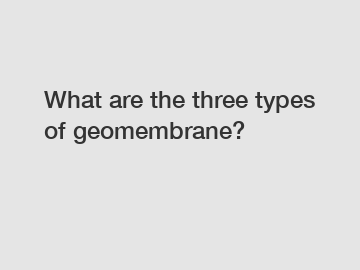Mar. 09, 2024
Construction
Are you familiar with geomembranes? They are essential materials in the construction and environmental industries. Geomembranes are impermeable sheets used for containment applications like lining landfills, ponds, and other structures to prevent leaks and seepage. There are three main types of geomembranes, each with its unique characteristics and uses. Let's explore them together.
1. High-Density Polyethylene (HDPE) Geomembranes.
One of the most common types of geomembranes is HDPE, made from high-density polyethylene resin. HDPE geomembranes are known for their high strength and durability, as well as their resistance to chemicals and punctures. They are commonly used in containment applications requiring a high level of chemical resistance, such as hazardous waste landfills and chemical storage ponds.

2. Linear Low-Density Polyethylene (LLDPE) Geomembranes.
LLDPE geomembranes are characterized by their flexibility and elongation properties, making them ideal for applications where settlement or movement of the underlying soil is expected. LLDPE geomembranes are often used in applications like floating covers for ponds or secondary containment structures where flexibility is essential. They are also resistant to ultraviolet (UV) radiation, making them suitable for outdoor applications.
3. Ethylene Propylene Diene Terpolymer (EPDM) Geomembranes.
EPDM geomembranes are synthetic rubbers known for their excellent weathering properties and resistance to UV radiation. They are highly flexible and have a high level of elongation, making them suitable for applications where movement of the underlying soil is a concern. EPDM geomembranes are commonly used in decorative pond liners, roofing membranes, and other applications requiring long-term durability and resistance to environmental factors.
Each type of geomembrane has its advantages and applications, so it's essential to choose the right one based on the specific requirements of your project. Consider factors like chemical resistance, flexibility, and weathering properties when selecting a geomembrane for your application.
Remember that proper installation and maintenance are crucial to the effectiveness of geomembranes. Ensure that the geomembrane is installed correctly, with proper seam welding and anchoring to prevent leaks and ensure long-term performance.
If you're unsure about which type of geomembrane is right for your project, don't hesitate to contact us. Our experienced team can help you choose the best geomembrane for your specific needs and provide guidance on installation and maintenance. As a reputable geomembrane supplier, we are committed to helping you find the right solution for your containment applications.
In conclusion, geomembranes play a vital role in containment applications, providing impermeable barriers to prevent leaks and seepage. Understanding the different types of geomembranes and their characteristics can help you choose the right material for your project. Whether you need HDPE, LLDPE, or EPDM geomembranes, we are here to assist you. Contact us today to learn more about our geomembrane solutions and find the perfect supplier for your needs.
For more ldpe smooth geomembrane specifications supplier, features and applications of geogrid, geosynthetics manufacturer and supplierinformation, please contact us. We will provide professional answers.
Previous: Top 10 benefits of aluminium roller shutters for businesses: Why should you invest in them?
If you are interested in sending in a Guest Blogger Submission,welcome to write for us!
All Comments ( 0 )